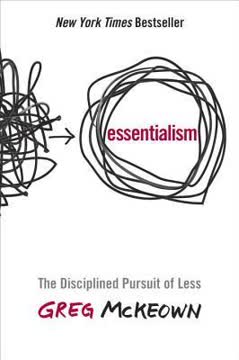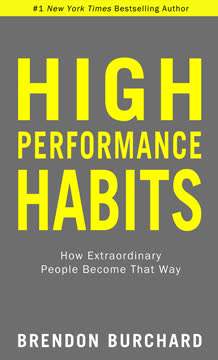Key Takeaways
1. Recognize that your life is composed of systems
Systems, systems, systems—everywhere!
Systems are ubiquitous. Your life is a collection of interconnected systems, from your daily routines to your business operations. These systems are not chaotic or mysterious; they are logical, predictable, and can be optimized. By recognizing this fundamental truth, you can begin to take control of your life and work.
Identify your systems:
- Personal: health, relationships, finances
- Professional: business processes, communication protocols, workflow
- Environmental: home organization, time management
Understanding that 99.9% of systems work efficiently can shift your perspective from feeling overwhelmed to feeling empowered. This recognition is the first step towards achieving the peace and prosperity you desire.
2. Adopt an outside and slightly elevated perspective
Once the work the system methodology is internalized and applied, you will be a different person.
Shift your viewpoint. Instead of being entangled in the day-to-day chaos, elevate your perspective to see the larger picture. This "outside and slightly elevated" viewpoint allows you to observe your life and business as a collection of systems that can be analyzed and improved.
Benefits of this perspective:
- Clearer decision-making
- Reduced emotional reactivity
- Improved problem-solving abilities
- Enhanced strategic thinking
By consistently maintaining this elevated perspective, you'll be able to identify inefficiencies, streamline processes, and make more informed choices. This shift in mindset is the foundation for transforming your life and business.
3. Document your goals, principles, and processes
Boring but true: to end workplace chaos, get the elements of it down on paper.
Create foundational documents. Develop three key documents to guide your business and personal life: the Strategic Objective, General Operating Principles, and Working Procedures. These documents serve as your compass, constitution, and laws, respectively.
- Strategic Objective: One-page overview of your goals and general strategy
- General Operating Principles: Guidelines for decision-making
- Working Procedures: Detailed, step-by-step instructions for recurring processes
These documents provide clarity, consistency, and direction. They allow you to delegate effectively, reduce errors, and ensure that your systems are operating in alignment with your overall vision. Regularly review and update these documents to reflect changes and improvements in your systems.
4. Focus on system improvement, not fire-killing
Instead of killing fires, you will spend your time creating a fireproof environment.
Shift from reactive to proactive. Instead of constantly responding to emergencies, dedicate your energy to improving the systems that prevent problems from occurring in the first place. This approach leads to long-term efficiency and stability.
Steps for system improvement:
- Identify recurring issues
- Analyze the underlying system
- Design and implement improvements
- Document the new process
- Monitor and refine
By consistently working on system improvement, you'll gradually eliminate the need for fire-killing, freeing up time and energy for more strategic activities. This shift in focus is key to achieving sustainable success and reducing stress in both your personal and professional life.
5. Implement the 'point-of-sale' strategy
Do it NOW. All actions build on "point-of-sale" theory.
Act immediately. The point-of-sale strategy emphasizes completing tasks as soon as they arise, rather than postponing them. This approach eliminates backlogs, reduces stress, and increases overall efficiency.
Benefits of point-of-sale action:
- Reduced mental clutter
- Improved focus on current tasks
- Decreased likelihood of forgetting important details
- Enhanced sense of accomplishment
Implement this strategy by creating systems that allow for immediate action. For example, set up automatic bill payments, respond to emails promptly, or address small maintenance issues as soon as they're noticed. By consistently applying the point-of-sale approach, you'll create a more streamlined and productive life and work environment.
6. Maximize your biological and mechanical prime time
Prime time is about maximizing productivity when brainpower is at peak capacity.
Leverage your peak hours. Identify your Biological Prime Time (BPT) - the hours when you're most alert and productive - and schedule your most important tasks during these periods. Similarly, focus on Mechanical Prime Time (MPT) - the time spent on system improvement and business building activities.
Optimizing your prime time:
- Track your energy levels to identify your BPT
- Schedule high-priority, complex tasks during BPT
- Dedicate MPT to strategic planning and system improvement
- Minimize distractions during prime time periods
By aligning your work schedule with your natural rhythms and focusing on high-value activities during your peak hours, you'll significantly increase your productivity and effectiveness. This strategy allows you to accomplish more in less time, creating space for personal pursuits and relaxation.
7. Cultivate quiet courage and consistent action
Quiet courage resides deep inside and causes one to buck up to do what needs to be done whether one wants to or not.
Develop inner strength. Quiet courage is the ability to take necessary action despite discomfort or fear. It's the antidote to procrastination and the key to consistent progress. By cultivating this trait, you'll be better equipped to implement and maintain your systems.
Strategies for developing quiet courage:
- Start with small, manageable tasks
- Celebrate small victories
- Visualize the long-term benefits of your actions
- Practice self-discipline in daily habits
Consistent action, fueled by quiet courage, is what transforms your systems from theoretical constructs into practical, life-changing tools. By regularly pushing through discomfort to maintain and improve your systems, you'll build momentum and achieve lasting results.
8. Create extraordinary systems operated by great people
This is what I want for you.
Build a high-performance team. Exceptional systems require exceptional people to operate them. Focus on creating an environment that attracts, develops, and retains top talent. This involves providing clear direction, ongoing training, and opportunities for growth.
Elements of a great team:
- Clear roles and responsibilities
- Well-documented processes
- Regular feedback and communication
- Opportunities for skill development
- Fair compensation and recognition
By combining extraordinary systems with great people, you create a powerful synergy that drives your business forward. This approach not only improves efficiency and productivity but also creates a more satisfying work environment for everyone involved.
9. Embrace the 98% perfection rule
In the work the system world, 98 percent accuracy is perfect because trying to achieve that additional 2 percent demands too much additional output.
Aim for excellence, not perfection. Striving for 100% perfection often leads to diminishing returns and unnecessary stress. Instead, focus on achieving a high level of quality (98%) efficiently, and then move on to the next task or improvement.
Applying the 98% rule:
- Set clear quality standards
- Establish checkpoints to ensure standards are met
- Recognize when additional effort yields minimal returns
- Allocate resources to areas with the highest impact
By embracing this principle, you'll maintain high standards while avoiding the paralysis of perfectionism. This balanced approach allows for continuous improvement and progress across all your systems, leading to better overall results in both your personal and professional life.
Last updated:
FAQ
What's Work the System about?
- Focus on Systems: Work the System by Sam Carpenter emphasizes viewing life and business as a collection of systems, each consisting of processes that can be optimized.
- Achieving Control: The book teaches that understanding and managing these systems can lead to increased efficiency and reduced chaos in both personal and professional settings.
- Practical Methodology: Carpenter provides a framework for identifying, documenting, and improving systems, which is essential for success.
Why should I read Work the System?
- Transformative Insights: The book offers insights that help shift your perspective from chaos to order, encouraging systematic thinking.
- Real-Life Applications: Carpenter shares his journey of transforming his chaotic business into a successful operation, offering relatable examples and actionable advice.
- Long-Term Benefits: Implementing the systems mindset can lead to reduced stress, increased productivity, and a more fulfilling life.
What are the key takeaways of Work the System?
- Systems Mindset: Adopting a systems mindset allows individuals to see their lives as manageable processes rather than chaotic events.
- Documentation is Crucial: Emphasizes the need for documentation, including Strategic Objective, General Operating Principles, and Working Procedures.
- Continuous Improvement: Advocates for regular assessment and refinement of processes for optimal performance.
What is the systems mindset in Work the System?
- Perspective Shift: Involves viewing life and business from an outside perspective to identify inefficiencies and areas for improvement.
- Focus on Mechanics: Understanding how systems operate leads to better decision-making and problem-solving.
- Empowerment through Control: Adopting this mindset empowers individuals to take control of their circumstances, leading to greater satisfaction.
What are the Strategic Objective and General Operating Principles in Work the System?
- Strategic Objective: A one-page document outlining goals and methods, serving as a guiding light for decision-making.
- General Operating Principles: Guidelines that inform decision-making, maintaining consistency and alignment with the Strategic Objective.
- Importance of Documentation: Both documents establish a clear framework for efficient system operation.
How does Work the System suggest improving personal and business systems?
- Identify and Isolate: Start by identifying and isolating individual systems for focused improvement.
- Document Processes: Document the processes involved in each system to serve as a reference for maintenance and improvement.
- Continuous Monitoring: Regularly monitor and tweak systems to ensure efficiency and effectiveness.
What is the significance of Working Procedures in Work the System?
- Operational Guidelines: Detailed instructions that ensure consistency and reliability in executing tasks.
- Foundation for Improvement: Provide a foundation for continuous improvement, updated based on feedback and results.
- Documentation of Success: Create a record of successful practices that can be replicated and scaled.
How do Working Procedures function in Work the System?
- Definition: Detailed, documented instructions for executing specific tasks, converting organic processes into predictable systems.
- Creation Process: Involves analyzing existing processes, identifying inefficiencies, and documenting improved steps.
- Living Documents: Continuously updated and refined to remain relevant and effective.
What is the importance of documentation in Work the System?
- Clarity and Consistency: Provides clarity and consistency in operations, reducing errors.
- Training and Onboarding: Facilitates training and onboarding, allowing tasks to be performed without needing to read the boss's mind.
- Long-term Efficiency: Achieves long-term efficiency and stability, leading to a more organized work environment.
What are some practical examples of systems in Work the System?
- Business Operations: Carpenter uses his telephone answering service, Centratel, as an example of optimizing systems for efficiency.
- Personal Life: Discusses personal systems like health routines, emphasizing structure and documentation for achieving goals.
- Everyday Tasks: Uses simple tasks to illustrate how mundane activities can be improved through a systems lens.
How can I start implementing the concepts from Work the System in my life?
- Begin with Awareness: Become aware of the systems in your life and how they operate, noting chaotic or inefficient areas.
- Create Documentation: Draft your Strategic Objective and General Operating Principles for clarity and direction.
- Take Action: Focus on one system at a time, documenting and improving it, and regularly review processes to ensure alignment with goals.
What are the best quotes from Work the System and what do they mean?
- “Control Is a Good Thing”: Emphasizes taking control of your life and systems for peace and success.
- “One should choose the simplest explanation”: Advocates for simplicity in problem-solving, avoiding overcomplication.
- “Your job is to prevent fires”: Highlights the need to focus on system improvement to avoid crises rather than reacting to them.
Review Summary
Work the System receives mixed reviews. Many praise its core message of breaking down life and business into systems for improvement, though some find it repetitive. Readers appreciate the author's personal experience and practical examples. Critics note the writing can be bland and ideas obvious to some. The book's value seems to depend on the reader's prior exposure to systems thinking. Some find it life-changing, while others see it as common sense repackaged. Overall, it's seen as potentially useful for business owners seeking organizational improvement.
Similar Books










Download PDF
Download EPUB
.epub digital book format is ideal for reading ebooks on phones, tablets, and e-readers.




